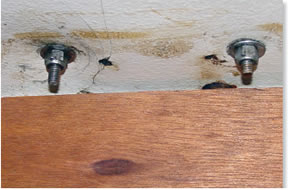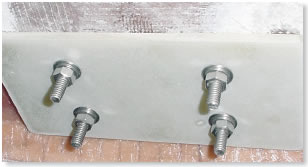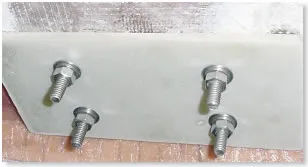
Photos by Frank Lanier and courtesy of PMI
288

Photos by Frank Lanier and courtesy of PMI
288
Do you have any suggestions on a book or manual that explains how to replace a cored deck where most of it is soaking wet? I replaced a 1.5-square-foot area and was surprised to see that it was so wet and rotten that I could grab the wood core and squeeze it like a sponge.
Steven Berlin
Morning Dew III, 1978 Ericson 29T
Pinepoint, Maine
There are two basic ways to repair waterlogged deck core. One is carried out by boring holes into the affected area, letting the core dry out, and then injecting the drilled holes with an epoxy resin. This method doesn’t work for many cases, however, and in your situation (when the core is saturated), we’d recommend the second way: peeling back the outer skin, scrape away the rotted core, replacing it with new core material, and re-bonding the outer skin with epoxy resin.
There are several online and print resources that can give you specific directions on how to do this. Our top pick for step-by-step advice on repairing water-damaged cored decks is “This Old Boat” by Don Casey, a DIY-er’s boat maintenance bible of sorts that we refer to frequently. Another helpful resource is Gougeon Bros.’ Epoxyworks magazine (www.epoxyworks.com). The maker of West Systems Epoxy, Gougeon Bros. (www.gougeon.com) offers multiple free boat maintenance how-to’s on the Epoxyworks and West System’s (www.westsystem.com) websites. On Epoxyworks, you’ll find the “Replacing damaged balsa core” article in the Boat Repair and Restoration section. You can also download a PDF of the article at www.westsystem.com.
Some past Practical Sailor articles worth checking out are “Core Issues in Hull Construction” (October 2007), which discusses core materials and securing a good bond between the core and skin laminates; our last test of moisture meters (July 15, 1998); and “Minor Repair to Cored Decks” online covers the epoxy resin-injection method of treating delamination.
Be sure that replacing soggy core is not a quick or fun project, but with the right tools and products, it is definitely a do-able feat for the do-it-yourselfer. We’re working on a test of epoxy resins for a future issue, but a popular one for this type of job is West Systems 105/206 with 407 filler.
Do you know if Bar Keepers Friend (www.barkeepersfriend.com), which contains oxalic acid and bicarb, is useful for cleaning stainless?
Paul J. Juettner
Due Professori, Catalina 350 MII
Stamford, Conn.
We’ve not yet tested Bar Keepers Friend on stainless, but we’ve heard good things about it from readers who’ve used it successfully in that application (and to clean stains from fiberglass). It’s bleach-free, but it does contain a small amount of oxalic acid (about 5%-10%). Its pH level is in the same slightly acidic range as lemon juice and vinegar. If you do use it on stainless, be sure to rinse the surfaces well with fresh water, otherwise the oxalic acid will leave a haze on the metal. Also, be sure to keep it away from any adjacent surfaces that are fabric or waxed fiberglass. For an acid-free metal polish, try Miracle Cloth (www.miraclecloth.com), PS’s Best Choice in our last test (February 2009).

































